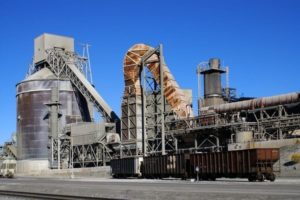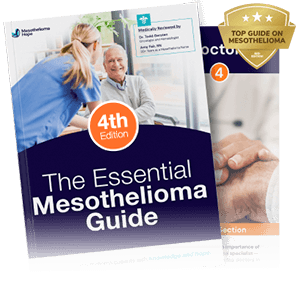Crane Operators and Asbestos Exposure
Until the early 1980s, the use of asbestos was commonplace. In addition to being inexpensive and easy to acquire, asbestos was popular because of its strength and its resistance to fire and chemicals.
For most of that time, the dangers of asbestos exposure — like its connection to mesothelioma — were unknown to the public. Asbestos was used in countless materials across many different industries, and while its use has been significantly reduced in the United States, many asbestos-containing products and materials still exist in homes, buildings, and work sites throughout the country.
Crane operators typically work in open-air environments without proper air filtration systems, making them especially vulnerable to airborne asbestos. Whether working in construction, renovation, and demolition or handling hazardous materials in mills and power plants, crane operators may be exposed to cancer-causing asbestos dust and fibers every time they go to work.
At Mesothelioma Hope, we understand the dangers of asbestos and the health conditions it can cause in workers who don’t even realize the hazards they face — and we’re here to help.
Request a copy of our comprehensive Mesothelioma Guide now and we’ll ship it overnight, free of charge.
What Asbestos Products Put Crane Operators at Risk?
Asbestos is harmless when it’s left alone. However, it becomes dangerous when asbestos-containing products are disturbed and asbestos fibers are tossed into the air, where they can be breathed in and settle in the lungs.
A crane operator’s job may involve moving or even destroying large materials — if those materials contain asbestos, the operators may be vulnerable to asbestos exposure.
Crane operators experience a high risk of asbestos exposure from materials like:
- Brake pads and lining
- Caulking
- Drywall
- Floor tiles
- Gaskets
- Insulation
- Packing materials
- Paint
- Protective gear
- Roofing products
These are just a few of the products that were made using asbestos between the 1930s and the early 1980s. Many materials that were made with asbestos are still in use today.
If you or a loved one developed malignant mesothelioma after being exposed to asbestos-containing products at work, reach out to one of our trusted Patient Advocates to learn how we can help.
Job Sites Where Crane Operators Encountered Asbestos
Crane operators can work on various different types of job sites, including in civilian and military environments. Unfortunately, asbestos may be found in any one of them.
Shipyards
Asbestos was so highly regarded for ship building that the U.S. Navy used it in nearly every one of its ships for more than four decades. Its soundproof and fireproof qualities made it an ideal choice for keeping ships quiet and resistant to combustion.
With asbestos becoming popular in the 1930s and the U.S. entering World War II in the early 1940s, the material was used in the production of thousands of Navy ships commissioned to build up the country’s naval fleet.
While veterans with mesothelioma who served on Navy ships may have had prolonged contact with asbestos-containing materials on and within the vessel, those who worked in the construction and demolition of these ships — like crane operators — may have had the highest risk of inhaling asbestos fibers.
Steel Mills
Work sites like steel mills are inherently hazardous, and asbestos was originally used to make them safer. Although the insulating and fireproofing qualities of asbestos may have protected steel mill workers from certain types of disasters, the asbestos itself ended up causing mesothelioma in workers who were exposed.
From loading and unloading materials to moving and pouring molten metal, cranes are necessary for steel mills to function. Unfortunately, crane operators who work in steel mills built before the 1980s may still be exposed to asbestos on a regular basis.
Power Plants

Power plants are another example of an environment in which asbestos was used with the intention of making the work site safer. As was the case in steel mills, the asbestos products used for insulating and fireproofing turbines and other power plant equipment are also hazardous.
Similar to steel mills, power plants rely on crane operators to lift, transport, and manipulate materials that may be too heavy or dangerous to work with in any other capacity. Power plants are already known to be dangerous, but asbestos has been an additional hidden danger for many decades.
Construction Sites
Although asbestos is generally non-threatening when it’s left alone, construction work may involve cutting, drilling, and sanding asbestos-containing building materials. Even though crane operators may not be directly involved in these processes, they work in the environments where they occur.
Crane operators who work on these sites and transport or manipulate construction materials are subject to inhaling or ingesting asbestos fibers that are tossed into the air. Without proper safety gear and ventilation, operators in the construction industry experience a higher risk for developing mesothelioma.
Demolition Sites
Demolition crews create clouds of dust, debris, and in some cases, asbestos. Whether the work site is an older building that’s being renovated or an entire apartment complex that’s being demolished, crane operators may be faced with airborne asbestos dust and fibers that end up in the lining of their lungs.
Get Help for Occupational Asbestos Exposure
Although asbestos is now heavily regulated and the Occupational Safety and Health Administration (OSHA) sets standards to minimize the possibility of asbestos exposure, tradespeople like crane operators are still at risk today.
Symptoms of mesothelioma can take 10-50 years to appear, which means it may be a long time between your last exposure to asbestos and your first experience of symptoms.
No matter how long it’s been since you were last exposed to asbestos, a mesothelioma lawyer may be able to help. Many mesothelioma patients and their family members are eligible for financial compensation from asbestos companies that they can use to cover medical bills, lost wages, and more.
Mesothelioma Hope has partnered with top law firm Simmons Hanly Conroy to fight for justice on behalf of those who developed mesothelioma and other asbestos-related diseases from occupational exposure.
If you have mesothelioma and were exposed to asbestos as a crane operator, contact us for a free case evaluation and find out how we can help.



 Get a Free Mesothelioma Case Review
Get a Free Mesothelioma Case Review




